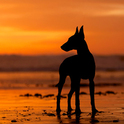About two weeks ago I posted here an open letter written by a group of canine geneticists to Poodle breeders, and especially those in Canada who are considering whether parti-colored dogs should be eligible to show in conformation.
We've entered a new age in genetics, and new information is coming out thick and fast in a language that isn't familiar to the average dog breeder. When this information produces significant new insights into the biology of dogs or a particular a breed, it is important that it be communicated effectively to dog breeders and with whatever additional background or expertise might be necessary to ensure that it is used appropriately. This is one of the reasons the Institute of Canine Biology was formed, and we anticipate that the need for this will only grow over time. To this end, we are preparing a longer, more detailed document that will provide breeders with the scientific information on which that letter was based and what it means.
In the meantime, I wanted to address here the single most critical issue underlying the basis for concern about the genetic health of the Standard Poodle breed, and that is population size. Breeders probably don't give much thought to the population size of their breed, except perhaps when it seems perilously low. In fact, however, population size can have a profound effect on the genetics of a dog breed in ways that are not intuitive. It is so important that breeders understand why this is such an important issue, so I am appending below the material I use in my class on basic population genetics. There are two exercises here for you to do - one that involves light and dark colored beans (or 2 colors of M&M's, or Jelly Bellies, or beads, or dog kibble - pick your poison) and one that is a computer simulation. PLEASE - don't skip the bean game. It seems hokey, and you're thinking you get this without having to actually do it, or whatever - but do it. It will take all of 10 minutes and will make the computer simulations so much more understandable. (download the document here)
These simulations are based on simple mathematics. There's no rocket science or string theory you have to understand in order to appreciate the point of the exercise, which is that population size matters - REALLY matters. If you've been in Poodles for longer than last weekend, you know about Wycliffe. The breed suffered a horrible bottleneck, leaving you with a large number of dogs that are all very closely related. Most of these dogs share a substantial fraction of their genes with many other dogs, so in fact the entire breed worldwide might be the genetic equivalent of only a few hundred dogs, or perhaps even substantially less. And only a small fraction of the puppies produced are subsequently bred, so the size of this population is small as well. The exercises above should have convinced you that small populations are genetically very unstable, and that genes can disappear or become fixed just by chance alone.
Parti-color Poodles, and even the solid-colored offspring of a parti-color dog, can be registered in Canada but not shown. If you can't show a parti poodle or its offspring, and you want to show poodles, you can't have parti-color dogs unless you're willing to breed in skipped-generations. Among show breeders, there will only be solid colored dogs; parti's will be effectively exiled. This effectively reduces the size of the show-dog population, and as you saw above this increases the genetic instability of that population. Breeders only realized after the deed was done the profound consequences the Wycliffe bottleneck would have on the breed. Everybody rushed to breed to those dogs because they were so exceptional, not realizing that every Wycliffe breeding prevented some other dog from passing its genes on to the next generation. The effect was the equivalent of a population bottleneck. Now, instead of "Wycliffe", the bottleneck is to be "solid color". With parti-color dogs and their progeny ("non-Wycliffe") banned from the show ring, the gene pool of the show lines will be reduced. This is not good. (There are additional genetic issues that also argue strongly against segregating parti-colored dogs from the show lines, that will be addressed in the longer document that will be forthcoming.)
In retrospect, I think many of today's breeders can recognize that the huge popularity of the Wycliffe dogs was bad for the breed. At the time, however, I would bet nobody gave it even a moment of thought. The geneticists that penned the open letter to Poodle breeders collectively fear that we are once again at a juncture where the wrong decision made by breeders - who might not fully understand the science behind the consequences - will have profound consequences for the breed.

